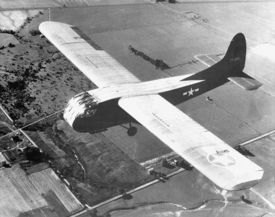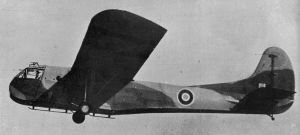PlaneSpottingWorld welcomes all new members! Please gives your ideas at the Terminal.
Waco CG-4 Haig
| CG-4 Haig[1] | |
|---|---|
| CG-4A Haig | |
| Type | Military glider |
| Manufacturer | WACO Aircraft Company |
| Maiden flight | 1942 |
| Primary users | US Army Air Forces Royal Air Force |
| Number built | > 13,903 |
The Waco CG-4 Haig (named Hadrian in Royal Air Force service) was the most widely used United States troop/cargo military glider of World War II. Designed by Weaver Aircraft Company of Ohio (commonly known by the acronym WACO, or Waco), CG-4 flight testing began in May of 1942 and eventually more than 13,900 CG-4As were delivered. Sixteen companies were prime contractors for manufacturing CG-4A's. Wicks Aircraft Company of Kansas City, Missouri was a sub-contractor while Commonwealth Aircraft Corporation of Kansas City, Kansas and the WACO Company of Troy, Ohio were two of the 16 prime contractors.
Contents
Design and development
The CG-4 was constructed of fabric-covered wood and metal and was crewed by a pilot and copilot. It could carry 13 troops and their equipment, or a quarter ton truck (Jeep), or a 75 mm howitzer, or a 1/4 ton trailer, loaded through the upward-hinged nose section. Also, a small bulldozer was loaded into some of these gliders. C-47s were usually used as tow aircraft. A few C-46 tugs were used for the Wesel mission.
The USAAF CG-4A tow line was 11/16" diameter nylon, 350' (107 m) long. The CG-4A pickup line was 15\16"- (24 mm)-diameter nylon, but only 225' (69 m) long including the doubled loop.
Operational history
Whiteman Air Force Base was originally activated on 6 August, 1942, as Sedalia Glider Base. In November 1942, the installation became Sedalia Army Air Field and was assigned to the 12th Troop Carrier Command of the United States Army Air Forces. The field served as a training site for glider pilots and paratroopers. Assigned aircraft included the CG-4A glider, and the Curtiss C-46s and Douglas C-47s. However, the C-46 was not used as a glider tug in combat until the Wesel mission.
CG-4As went into operation in July 1943 during the Allied invasion of Sicily. They participated in the American airborne landings in Normandy on 6 June, 1944, and in other important airborne operations in Europe and in the China-Burma-India Theater. Although not the intention of the AAF, gliders were generally considered expendable by high ranking European theater officers and combat personnel and were abandoned or destroyed after landing. While equipment and methods for extracting flyable gliders was developed and was delivered to Europe, half of that equipment was rendered unavailable by certain higher ranked officers. Despite this lack of support for the recovery system several gliders were recovered from Normandy and even more from Holland and Wesel.
The CG-4A found favor where its small size was a benefit; the larger Airspeed Horsa could carry more troops (seating for 28 or a jeep or an anti-tank gun) and the General Aircraft Hamilcar could carry a light tank but the CG-4A could land in smaller spaces. It was used to send supplies to partisans in Yugoslavia.
Variants
- XCG-4
- Prototypes, two built, plus one stress test article.
- CG-4A
- Main Production variant, survivors became G-4A in 1948, 13,903 built by 16 various contractors.
- XCG-4B
- One CG-4A built with a plywood structure.
- XPG-1
- One CG-4A converted with two Franklin 6AC-298-N3 engines by Northwestern.
- XPG-2
- One CG-4A converted with two 175hp L-440-1 engines by Ridgefield.
- XPG-2A
- Two articles: XPG-2 engines changed to 200hp. plus one CG-4A converted also with 200hp engines..
- PG-2A
- production PG-2A with two 200hp L-440-7s, redesignated G-2A in 1948, ten built by Northwestern.
- XPG-2B
- Cancelled variant with two R-775-9 engines.
- LRW-1
- 13 CG-4A transferred to the United States Navy.
- G-2A
- PG-2A re-designated in 1948.
- G-4A
- CG-4A re-designated in 1948.
- G-4C
- G-4A with different tow-bar, 35 conversions.
- Hadrian Mk I
- Royal Air Force designation for the CG-4A, 25 delivered.
- Hadrian Mk II
- Royal Air Force designation for the CG-4A with equipment changes.
Operators
- Czechoslovakian Air Force operated 2 or 3 Wacos, designated NK-4.
Specifications (CG-4A)
General characteristics
- Crew: two (pilot and co-pilot)
- Capacity: 13 troops, or quarter-ton truck and 3 troops, or 6 litters
- Length: 48 ft 8 in (14.8 m)
- Wingspan: 83 ft 8 in (25.5 m)
- Height: 15 ft 4 in (4.7 m)
- Wing area: 900 ft² (83.6 m²)
- Empty weight: 3,790 lb (1,719 kg)
- Loaded weight: 7,500 lb maximum design gross weight (normal load) / 9,000 lb maximum emergency gross weight (not to be exceeded) (3,400 kg / 4,091 kg)
- Max takeoff weight: 7,500 lb (3,400 kg)
- *Max take off (Emergency Load): 9,000 lb (4,091 kg)
Performance
- Maximum speed: 150 mph[2] @ 7,500 lb (240 km/h[3] @ 3,400 kg;)
- Cruise speed: CAS 72.6 mph[4] (CAS 117 km/h[5])
- Stall speed: CAS 49 mph[6] with design load 7,500 lb (CAS 79 km/h[7] with design load 3,400 kg)
- Wing loading: 8.81 lb/ft² ()
- Rate of sink: About 400 ft/min (122 m/min) at tactical glide speed (CAS 60 mph/96 km/h)
- Landing run: 600-800 feet (180-244 m) for normal three-point landing
References
External links
- The Assault Glider Trust
- www.silentwingsmuseum.info
- U.S. Army Airborne and Special Operations Museum, World War II CG-4A Glider Exhibit, Fort Bragg, NC (www.army.mil)
See also
Related development
Comparable aircraft
- Airspeed Horsa
- Slingsby Hengist
- General Aircraft Hamilcar
- General Aircraft Hotspur
- DFS 230
- Gotha Go 242
Designation sequence
Related lists
Lists relating to aviation | |
|---|---|
| General | Timeline of aviation · Aircraft · Aircraft manufacturers · Aircraft engines · Aircraft engine manufacturers · Airports · Airlines |
| Military | Air forces · Aircraft weapons · Missiles · Unmanned aerial vehicles (UAVs) · Experimental aircraft |
| Notable incidents and accidents | Military aviation · Airliners · General aviation · Famous aviation-related deaths |
| Records | Flight airspeed record · Flight distance record · Flight altitude record · Flight endurance record · Most produced aircraft |
Template:USAAF glider aircraft Template:USAF glider aircraft
Lists relating to aviation | |
|---|---|
| General | Timeline of aviation · Aircraft · Aircraft manufacturers · Aircraft engines · Aircraft engine manufacturers · Airports · Airlines |
| Military | Air forces · Aircraft weapons · Missiles · Unmanned aerial vehicles (UAVs) · Experimental aircraft |
| Notable incidents and accidents | Military aviation · Airliners · General aviation · Famous aviation-related deaths |
| Records | Flight airspeed record · Flight distance record · Flight altitude record · Flight endurance record · Most produced aircraft |
cs:Waco CG-4 de:Waco CG-4A es:CG-Hadrian pl:Waco CG-4
| This article is licensed under the GNU Free Documentation License. It uses material from the Wikipedia article "Waco CG-4 Haig". |


